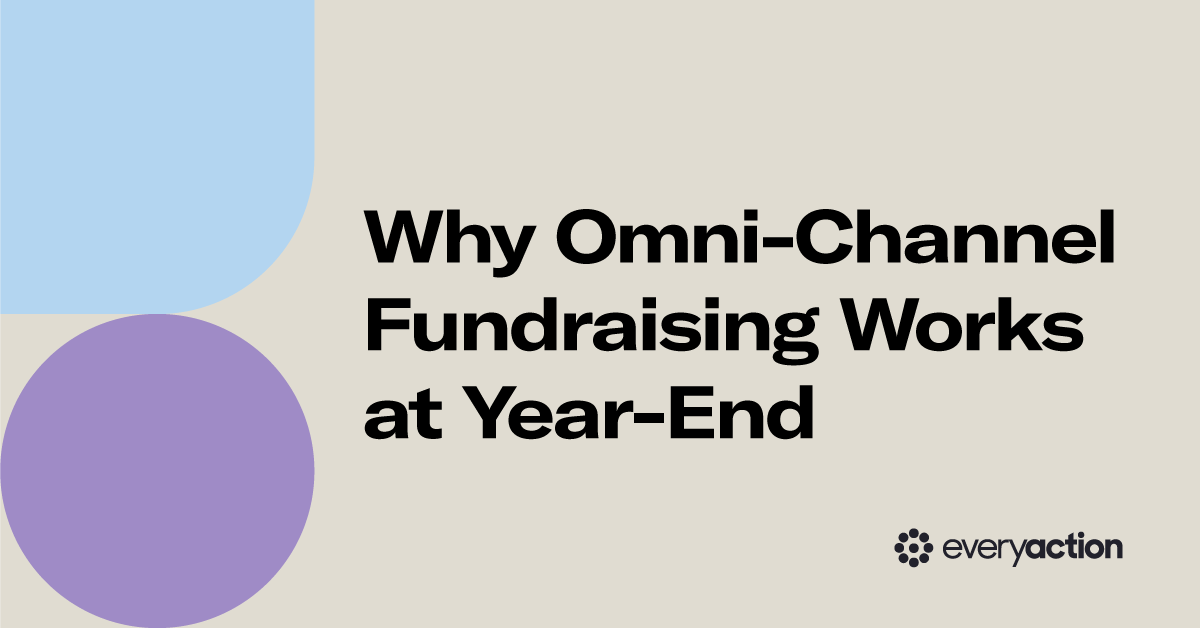Why Omni-Channel Fundraising Works at Year-End

Whether you’ve used a unified, omni-channel engagement strategy for years or you’re just getting started, busy fundraising seasons are the most important opportunities to communicate cohesively across mediums with your supporters. Here’s EveryAction’s General Manager for Digital, Mike Liddell, with a story about why omni-channel works so well at year-end.
Q: Can you share a good example of channels working together effectively at end-of-year? Why is this strategy so useful for nonprofits?
A: To understand why an omni-channel strategy works so well at year-end, think about the ways brands and organizations interact with you leading up to the holidays.
I could walk you through the data and stats that we have on omni-channel and the effects we’ve seen from different nonprofits who’ve used these techniques and tactics to really great effect, but what I like to think about is your own personal life. The holidays are coming up, so think about how you’re being communicated with by brands. As they’re trying to persuade you to purchase their products for the holidays, notice how those communications are coming in to you in a cohesive, accurate-in-real-time way—but they’re not coming to you in just one channel or avenue. You can apply a lot of these same techniques to your nonprofit omni-channel fundraising.
Digital ads
For example, say you’re interested in buying a TV, or a really cool new toy for your children. You’d likely decide to visit websites to do some research, which means you probably now have some ads following you around. Digital ads have had an interesting year in the nonprofit world: despite conversation earlier this year among digital thought leaders about the effect Apple’s iOS 14 and 14.5 updates are expected to have on the amount of granular data available from digital ad clicks, nonprofits who adapt metrics and goals to meet the moment may find ads are still a useful part of your omni-channel campaigns.
Let’s say you continue your search for a holiday gift, and you decide to enter your email address somewhere in your search for information. This means now you’re probably getting email targeting you with more content and reminders about the item you were looking for. In the nonprofit world, we know email continues to be a popular and effective channel for supporter stewardship and fundraising. To give just one recent indicator of email’s continued success as a fundraising channel, on GivingTuesday 2021, organizations on the EveryAction platform sent 149 million emails and saw overall average online donation revenue go up by 41 percent compared to GivingTuesday 2020. Although these results are pretty incredible (GivingTuesday 2021 even broke our single-day email send record!), it’s always important to balance email volume with targeting the right donor segments so that each one of your supporters receives the right email messages as part of your omni-channel strategy.
Direct mail
As your journey to purchase the perfect holiday gift continues, you might receive some direct mail that has ads mentioning the item you had your eye on. It’s easy to understand why brands use direct mail: in the nonprofit world, mail can be an especially powerful tool for educating your supporters. It’s a rare occasion for you to earn their full and undivided attention, with some beautiful visuals and compelling information that will stick in their mind even if they don’t drop everything and mail in a gift immediately.
SMS messages
Another tool you might see brands adding to the mix of channels they’re using to message you in a cohesive way is SMS communications—maybe you decide to enter your mobile phone number in exchange for a coupon, and now you receive the occasional message. In the nonprofit world, we know SMS is hard to beat when it comes to urgency and open rates: M+R’s 2021 Benchmarks reported that in 2020, audience sizes for SMS grew by 26 percent over the previous year, and the clickthrough rate for mobile fundraising messages was three times higher than the clickthrough rate for email fundraising messages. Those kinds of results help explain why we’re seeing organizations start to add SMS to their omni-channel repertoire.
Adapting to an omni-channel world
You can see clearly how we already live in an omni-channel world just by looking around, especially during the holiday season. Say everyone’s sitting at home on the couch, and the holiday movie you watch together every year is playing. Some of you might be giving the movie your undivided attention, but if you look around, you might see that other folks in your family are multi-tasking. The TV might be on, but people are probably also on their phones, checking email or getting a text message or reading a website. This is a clear illustration of the omni-channel world we live in: we really are constantly receiving data in and out, using different channels for different purposes; we’re being advertised and talked to in all these different ways, and that’s why it’s so important for nonprofits to adapt to this reality and learn how to communicate with dedicated supporters in this interconnected, cross-channel environment.


